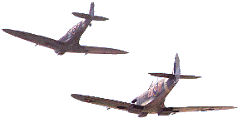
High Flight by John Magee
Oh, I have slipped the surly bonds of earth,
And danced the skies on laughter-silvered wings;
Sunwards I’ve climbed and joined the tumbling mirth
Of sun-split clouds – and done a thousand things
You have not dreamed of - wheeled and soared and swung
High in the sunlit silence. Hovering there,
I’ve chased the shouting wind along and flung
My eager craft through footless halls of air,
Up, up the long delirious burning blue
I’ve topped the wind-swept heights with easy grace,
Where never lark, or even eagle, flew;
And, while with silent, lifting mind I’ve trod
The high untrespassed sanctity of space,
Put out my hand, and touched the face of god.

| During the dark days of the Battle
of Britain, hundreds of Americans crossed the border into Canada to enlist
with the Royal Canadian Air Force. Knowingly breaking the law, but with
the tacit approval of the then still officially neutral United States
Government, they volunteered to fight Hitler's Germany. John Gillespie Magee, Jr., was one such American. Born in Shanghai, China, in 1922 to an English mother and a Scotch-Irish-American father, Magee was just 18 years old when he entered flight training. Within the year, he was sent to England and posted to the newly formed No 412 Fighter Squadron, RCAF, which was activated at Digby, England, on 30 June 1941. He was qualified on and flew the Supermarine Spitfire. Flying fighter sweeps over France and air defense over England against the German Luftwaffe, he rose to the rank of Pilot Officer. At the time, German bombers were crossing the English Channel with great regularity to attack Britain's cities and factories. Although the Battle of Britain was said to be over, the Luftwaffe was still keeping up deadly pressure on British industry and the country. On September 3, 1941, Magee flew a high altitude (30,000 feet) test flight in a newer model of the Spitfire V. As he orbited and climbed upward, he was struck with the inspiration of a poem -- "To touch the face of God." Once back on the ground, he wrote a letter to his parents. In it he commented, "I am enclosing a verse I wrote the other day. It started at 30,000 feet, and was finished soon after I landed." On the back of the letter, he jotted down his poem, 'High Flight'. Just three months later, on December 11, 1941 (and only three days after the US entered the war), Pilot Officer John Gillespie Magee, Jr., was killed. The Spitfire V he was flying, VZ-H, collided with an Oxford Trainer from Cranwell Airfield flown by one Ernest Aubrey. The mid-air happened over Tangmere, England at about 400 feet AGL at 11:30. John was descending in the clouds. At the enquiry a farmer testified that he saw the Spitfire pilot struggle to push back the canopy. The pilot, he said, finally stood up to jump from the plane. John, however, was too close to the ground for his parachute to open. He died instantly. He was 19 years old. Part of the official letter to his parents read, "Your son's funeral took place at Scopwick Cemetery, near Digby Aerodrome, at 2:30 P.M. on Saturday, 13th December, 1941, the service being conducted by Flight Lieutenant S. K. Belton, the Canadian padre of this Station. He was accorded full Service Honors, the coffin being carried by pilots of his own Squadron." Inspiration to all? |
|
|
| Pilot Officer John Magee
Jr author of High Flight collided with an Airspeed Oxford from RAF
Cranwell, not far from RAF Digby - not over Tangmere which was a fighter
station on the South Coast many miles away. Both aircraft crashed in the
same field, about 3 miles west of RAF Digby. I have been researching Pilot Officer Magee's background and found the reference to Tangmere which appears erroneous, in many accounts. I was Signals Officer at RAF Digby during WW2 and one of my hobbies is writing articles for RAF publications. - Everett Brown |